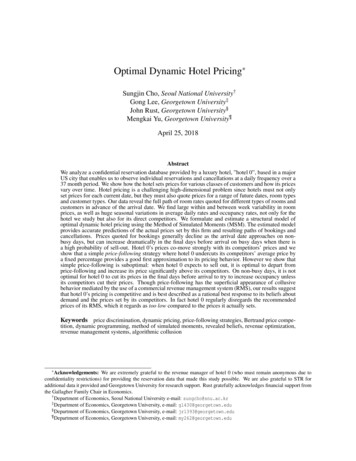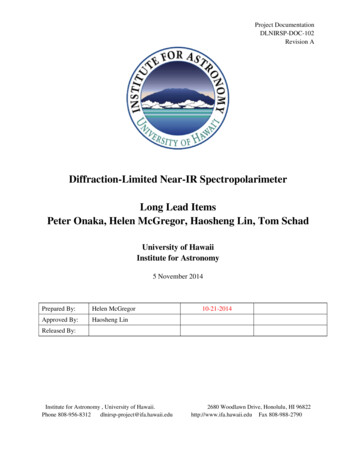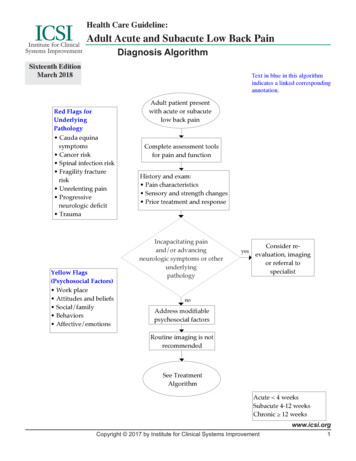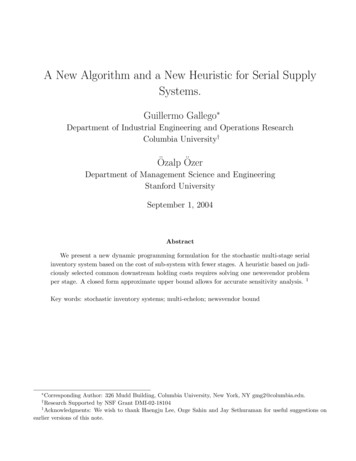
Transcription
A Dynamic Near-Optimal Algorithm for Online Linear ProgrammingShipra AgrawalDepartment of Computer Science, Stanford University, Stanford, CAemail: shipra@cs.stanford.eduZizhuo WangDepartment of Management Science and Engineering, Stanford University, Stanford, CAemail: zzwang@stanford.eduYinyu YeDepartment of Management Science and Engineering, Stanford University, Stanford, CAemail: yinyu-ye@stanford.eduA natural optimization model that formulates many online resource allocation and revenue management problemsis the online linear program (LP) where the constraint matrix is revealed column by column along with theobjective function. We provide a near-optimal algorithm for this surprisingly general class of online problemsunder the assumption of random order of arrival and some mild conditions on the size of the LP right-hand-sideinput. Our learning-based algorithm works by dynamically updating a threshold price vector at geometric timeintervals, where the dual prices learned from revealed columns in the previous period are used to determine thesequential decisions in the current period. Our algorithm has a feature of “learning by doing”, and the pricesare updated at a carefully chosen pace that is neither too fast nor too slow. In particular, our algorithm doesn’tassume any distribution information on the input itself, thus is robust to data uncertainty and variations due toits dynamic learning capability. Applications of our algorithm include many online multi-resource allocation andmulti-product revenue management problems such as online routing and packing, online combinatorial auctions,adwords matching, inventory control and yield management.Key words: online algorithms; linear programming; primal-dual; dynamic price updateMSC2000 Subject Classification: Primary: 68W27, 90B99; Secondary: 90B05, 90B50, 90C05OR/MS subject classification: Primary: Linear Programming; analysis of algorithms1. Introduction Online optimization is attracting an increasingly wide attention in computer science, operations research, and management science communities because of its wide applications toelectronic markets and dynamic resource allocation problems. In many practical problems, data does notreveal itself at the beginning, but rather comes in an online fashion. For example, in the online revenuemanagement problem, consumers arrive sequentially requesting a subset of goods (multi-leg flights or aperiod of stay in a hotel), each offering a certain bid price for his demand. On observing a request, theseller needs to make an irrevocable decision for that consumer with the overall objective of maximizingthe revenue while respecting the resource constraints. Similarly, in the online routing problem [8, 3],the central organizer receives demands for subsets of edges in a network from the users in a sequentialmanner, each with a certain utility and bid price for his demand. The organizer needs to allocate thenetwork capacity online to those bidders to maximize social welfare. A similar format also appears inonline auctions [4, 10], online keyword matching problems [13, 20, 23, 16], online packing problems [9],and various other online revenue management and resource allocation problems [22, 11, 6].In all these examples mentioned above, the problem can be formulated as an online linear programmingproblem1 . In an online linear programming problem, the constraint matrix is revealed column by columnwith the corresponding coefficient in the objective function. After observing the input arrived so far,the online algorithm must make the current decision without observing the future data. To be precise,consider the linear programPnmaximizeπ xPnj 1 j jsubject toa(1)j 1 ij xj bi , i 1, . . . , m0 xj 1j 1, . . . , nmmmwhere j, πj 0, aj (aij )mi 1 [0, 1] , and b {bi }i 1 R . In the corresponding online problem,at time t, the coefficients (πt , at ) are revealed, and the algorithm must make a decision xt . Given the1 In fact, many of the problems mentioned above take the form of an integer program. While we discuss our ideas andresults in terms of linear relaxation of these problems, our results naturally extends to integer programs. See Section 5.4for the detailed discussion.1
2Agrawal et al.: A Dynamic Near-Optimal Algorithm for Online Linear ProgrammingMathematics of Operations Research xx(x), pp. xxx–xxx, c 200x INFORMSprevious t 1 decisions x1 , . . . , xt 1 , and input {πj , aj }tj 1 until time t, the tth decision is to select xtsuch thatPtj 1 aij xj bi , i 1, . . . , m(2)0 xt 1.PnThe goal of the online algorithm is to choose xt ’s such that the objective function t 1 πt xt is maximized.To evaluate an online algorithm, one could consider various kinds of input models. One approach, whichis completely robust to input uncertainty, is the worst-case analysis, that is, to evaluate the algorithmbased on its performance on the worst-case input [23, 9]. However, this leads to very pessimistic boundsfor the above online problem: no online algorithm can achieve better than O(1/n) approximation of theoptimal offline solution [4]. The other approach, popular among practitioners with domain knowledge, isto assume certain distribution on the inputs and consider the expected objective value achieved by thealgorithm. In many cases, a priori input distribution can simplify the problem to a great extent, however,the choice of distribution is very critical and the performance can suffer if the actual input distributionis not as assumed. In this paper, we take an intermediate path. While we do not assume any knowledgeof the input distribution, we relax the worst-case model by making the following two assumptions:Assumption 1.1 The columns aj (with the objective coefficient πj ) arrive in a random order, i.e., theset of columns can be adversarily picked at the start. However, after they are chosen, (a1 , a2 , ., an ) and(aσ(1) , aσ(2) , ., aσ(n) ) have same chance to happen for all permutation σ.This assumption says that we consider the average behavior of the online algorithm over randompermutations. This assumption is reasonable in practical problems, since the order of columns usuallyappears to be independent of the content of the columns. We like to emphasize that this assumptionis strictly weaker than assuming an input distribution. In particular, it is automatically satisfied if theinput columns are generated independently from some common (but unknown) distributions. This is alsoa standard assumption in many existing literature on solving online problems [4, 13, 20, 17].Assumption 1.2 We know the total number of columns n a priori.The second assumption is needed since we will use quantity n to decide the length of history used tolearn the threshold prices in our algorithm. It can be relaxed to an approximate knowledge of n (withinat most 1 multiplicative error), without affecting the final results. Note that this assumption is alsostandard in many existing algorithms for online problems [4] in computer science. For many practicalproblems, the knowledge of n can be implied approximately by the length of time horizon T and thearrival rates, which is usually available. As long as the time horizon is long enough, the total numberof arrivals in the LP problem will be highly accurate. This is justified in [11] and [19] when they usethe expected number of arrivals for constructing a pricing policy in a revenue management problem.Moreover, this assumption is necessary from the algorithmic point of view. In [13], the authors showedthat if Assumption 2 doesn’t hold, then the worst-case competitive ratio is bounded away from 1 evenwe admit Assumption 1.In this paper, we present an almost optimal solution for online linear program (2) under the above twoassumptions and a lower bound condition on the size of b. We also extend our results to the followingmore general online linear optimization problems: Problems with multi-dimensional decisions at each time step. More precisely, consider a sequenceof n non-negative vectors f 1 , f 2 , . . . , f n Rk , mn non-negative vectorsg i1 , g i2 , . . . , g in [0, 1]k ,ki 1, . . . , m,Tand (k 1)-dimensional simplex K {x R : x e 1, x 0}. In this problem, giventhe previous t 1 decisions x1 , . . . , xt 1 , each time we make a k-dimensional decision xt Rk ,satisfying:PtTj 1 g ij xj bi , i 1, . . . , m(3)xt Kwhere decision Pvector xt must be chosen only using the knowledge up to time t. The objectivenis to maximize j 1 f Tj xj over the whole time horizon. Note that Problem (2) is a special caseof Problem (3) with k 1.
Agrawal et al.: A Dynamic Near-Optimal Algorithm for Online Linear ProgrammingMathematics of Operations Research xx(x), pp. xxx–xxx, c 200x INFORMS3 Problem (2) with both buy-and-sell orders, that is,mπj either positive or negative, and aj (aij )mi 1 [ 1, 1] .(4)1.1 Our key ideas and main results In the following, let OPT denote the optimal objective valuefor the offline problem (1).Definition 1.1 An online algorithm A is c-competitive in random permutation model if the expectedvalue of the online solution obtained by using A is at least c factor of the optimal offline solution. Thatis,PnEσ [ t 1 πt xt (σ, A)] cOPTwhere the expectation is taken over uniformly random permutations σ of 1, . . . , n, and xt (σ, A) is the tthdecision made by algorithm A when the inputs arrive in the order σ.Our algorithm is based on the observation that the optimal solution x for the offline linear programis almost entirely determined by the optimal dual solution p Rm corresponding to the m inequalityconstraints. The optimal dual solution acts as a threshold price so that x j 0 only if πj p T aj . Ouronline algorithm works by learning a threshold price vector from the input received so far. The pricevector then determines the decision for the next period. However, instead of computing a new pricevector at every step, the algorithm initially waits until n steps or arrivals, and then computes a newprice vector every time the history doubles. That is, at time steps n , 2n , 4n , . . . and so on. We showthat our algorithm is 1 O( )-competitive in random permutation model under a size condition of theright-hand-side input. Our main results are precisely stated as follows:Theorem 1.1 For any 0, our online algorithm is 1 O( ) competitive for the online linear program(2) in random permutation model, for all inputs such that 2 m log (n/ )B min bi Ω(5)i 2Note that the condition in Theorem 1.1 depends on log n, which is far from satisfying everyone’sdemand when n is large. In [21], the author proves that k 1/ 2 is necessary to get 1 O( ) competitiveratio in k-secretary problem, which is the single dimensional case of our problem with m 1, B kand at 1 for all t. Thus, dependence on in the above theorem is near-optimal. In the next theorem,we show that a dependence on m is necessary as well for any online algorithm to obtain a near-optimalsolution. Its proof will appear in Section 4.Theorem 1.2 For any online algorithm for linear program (2) in random permutation model, there existsan instance such that its competitive ratio is less than 1 Ω( ) whenlog(m)B min bi i 2We also extend our results to more general online linear programs as introduced in (3) and (4):Theorem 1.3 For any 0, our algorithm is 1 O( ) competitive for the general online linear problem(3) or (4) in random permutation model, for all inputs such that: m log (nk/ )B min bi Ω.(6)i 2Remark 1.1 Our condition to hold the main result is independent of the size of OPT or objective coefficients, and is also independent of any possible distribution of input data. If the largest entry of constraintcoefficients does not equal to 1, then our both theorems hold if the condition (5) or (6) is replaced by: bim log (nk/ ) Ω, i,āi 22 For any two functions f (n), g(n), f (n) O(g(n)) iff there exists some constant c such that f (n) c g(n); and11f (n) Ω(g(n)) iff there exists some constant c2 such that f (n) c2 g(n). The precise constants required here will beillustrated later in the text.
4Agrawal et al.: A Dynamic Near-Optimal Algorithm for Online Linear ProgrammingMathematics of Operations Research xx(x), pp. xxx–xxx, c 200x INFORMSwhere, for each row i, āi maxj { aij } of (2) and (4), or āi maxj {kg ij k } of (3). Note that thisbound is proportional only to log(n) so that it is way below to satisfy everyone’s demand.It is apparent that our generalized problem formulation should cover a wide range of online decisionmaking problems. In the next section, we discuss the related work and some sample applications of ourmodel. As one can see, our result in fact improves the best competitive ratios for many online problemsstudied in the literature and presents the first non-asymptotic analysis for solving many online resourceallocation and revenue management problems.1.2 Related work Online decision making has been a topic of wide recent interest in the computerscience, operations research, and management science communities. Various special cases of the generalproblem presented in this paper have been studied extensively in the computer science literature as“secretary problems”. A comprehensive survey of existing results on the secretary problems can be foundin [4]. In particular, constant factor competitive ratios have been proven for k-secretary and knapsacksecretary problems under random permutation model. Further, for many of these problems, a constantcompetitive ratio is known to be optimal if no additional conditions on input are assumed. Therefore,there has been recent interest in searching for online algorithms whose competitive ratio approaches 1 asthe input parameters become large. The first result of this kind appears in [21], where a 1 O(1/ k)competitive algorithm is presented for k secretary problem under random permutation model. Recently,the authors
Department of Management Science and Engineering, Stanford University, Stanford, CA email: yinyu-ye@stanford.edu A natural optimization model that formulates many online resource allocation and revenue management problems is the online linear program (LP) where the constraint matrix is revealed column by column along with the objective function. We provide a near-optimal algorithm for this .











